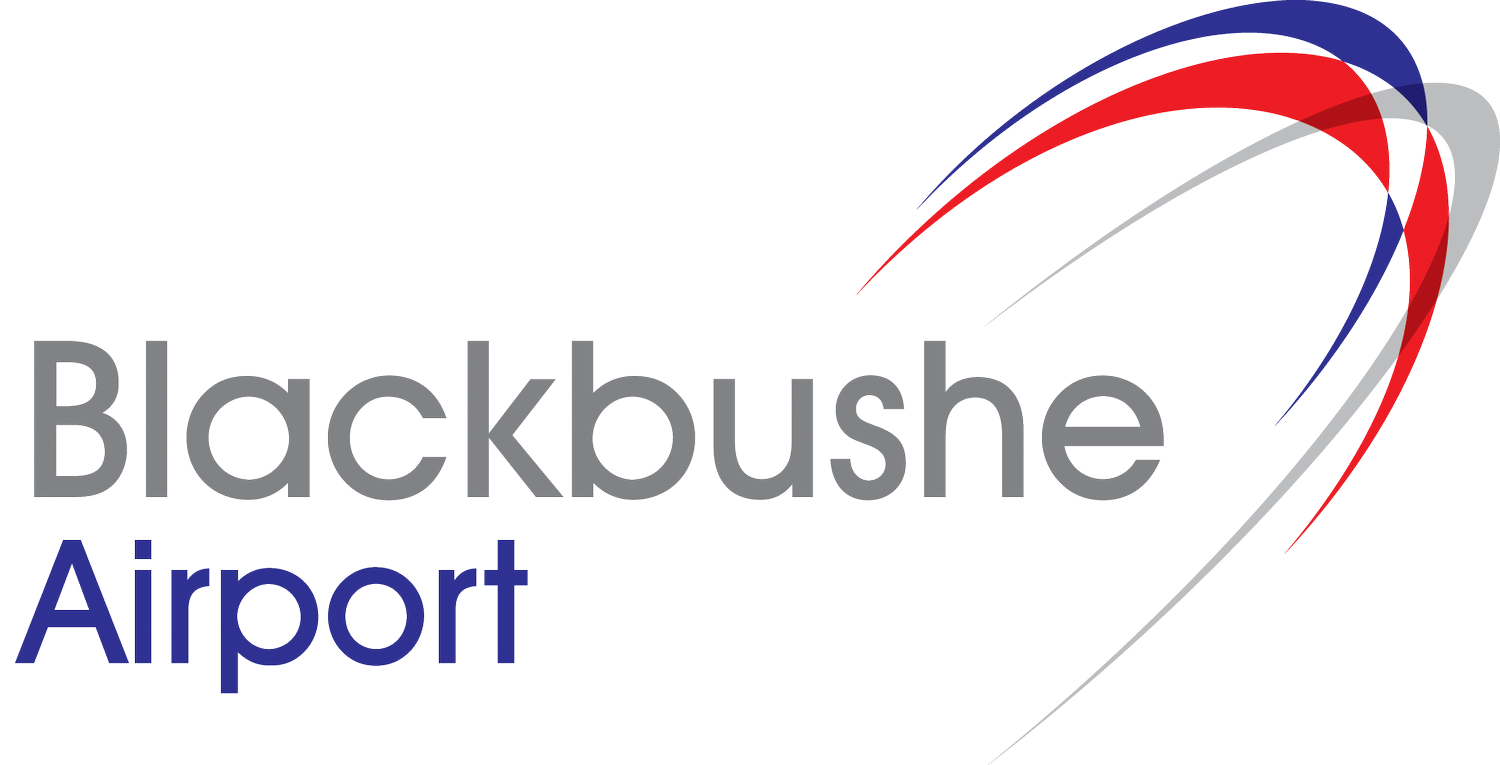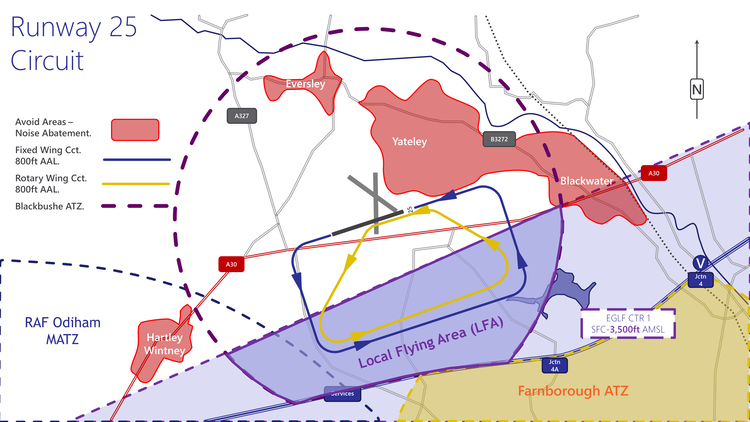Preventing Infringements of the Farnborough Controlled Airspace in the vicinity of Blackbushe AIrport
This infringement update is the nineteenth in a series of narratives focusing on identified infringement hot-spots in the UK. It has been written by the team at Blackbushe Airport, Farnborough Air Traffic Service Unit and members of the Wessex Local Airspace Infringement Team.
The Farnborough Controlled Airspace (CAS) complex was implemented on 27 February 2020. During the first 4 months there were 17 reported airspace infringements involving aircraft departing or arriving at Blackbushe; 58% of these related to aircraft vacating the Blackbushe Local Flying Area (LFA) and infringing the Farnborough Control Zone (CTR-1)
Blackbushe aerodrome is surrounded by an aerodrome traffic zone (ATZ) of 2NM radius, except that part of the circle located directly above of and to south of the M3 Motorway. The ATZ extends from the surface to 2,000 feet AAL (2,325 feet AMSL). (Figure 1).
Figure 1 Farnborough CAS complex
Whilst the aerodrome lies within Class G airspace, part of the Blackbushe ATZ lies within the Class D Farnborough CTR-1. The area of overlap between the EGLK ATZ and EGLF CTR-1 forms the Blackbushe LFA . The LFA dimensions are promulgated in in the UK AIP at AD2.22.4 LOCAL FLYING AREA. It is shown in Figure 2 which is published on the Blackbushe Airport website at https://www.blackbusheairport.co.uk/aerodrome.
The LFA is available from surface to 2,000 feet AMSL (1,675 feet AAL) to VFR flights. SVFR operations within the LFA require a clearance from Farnborough Radar, and are required to be separated from other SVFR/IFR aircraft. As a result, issuance of such a clearance from Farnborough Radar would be available to only one aircraft at a time.
Figure 2 Blackbushe LFA
Aircraft JOINING/OPERATING in the Blackbushe Visual Circuit
Runway 25
The majority of the airspace infringements to date have resulted from pilots extending downwind in the Runway 25 visual circuit (Figure 3) and leaving the LFA in the vicinity of Hawley Lake. The AIP entry for the LFA states “Pilots are required to contain their circuits within the LFA and ATZ. In particular, on Runway 25 note to turn base leg west of Hawley Lake to avoid infringing the CTR to the east.” In addition, on the Blackbushe Airport Information page pilots are advised to “Turn Base Leg before reaching Hawley Lake to ensure circuits remain inside the ATZ/LFA. If aircraft ahead are establishing a wider circuit, do not follow, but reposition deadside or orbit as appropriate, and in communication with ATSU.”
If the visual circuit is extending to the east and there is a possibility that you might leave the LFA, make a positive, early decision to reposition deadside for another circuit; DO NOT extend over or to the east of Hawley Lake.
Figure 3 Blackbushe R25
Runway 07
When joining for Runway 07 turn base leg When joining or descending deadside, take care to remain west of Yateley. Follow the path of disused runway 14/32, keeping it to the left at all times.
Turn Base Leg before reaching The Elvetham Hotel (and abeam Fleet Services) to ensure circuits remain inside the ATZ/LFA. If aircraft ahead are establishing a wider circuit, do not follow, but reposition deadside or orbit as appropriate, and in communication with ATSU. (Figure 4).
Figure 4 Blackbushe R07
If you are re-joining the circuit, you must ensure that you are squawking 7010 prior to entering the LFA. Where you are entering the LFA from the south (within the Farnborough CTR-1), you may either retain the squawk issued for your transit, or select 7010 once North of the M3.
General Circuit Procedures
Circuit Procedures
Circuits are always to the south of the Airfield and are flown at 800 feet QFE for most fixed wing aircraft.
For jet, turbo-prop, or other high-performance traffic, circuits are flown at 1,200 feet QFE.
Rotary wing circuits are flown at 800 feet QFE typically inside the fixed wing circuit. All pilots should be aware of rotary traffic using non-standard circuits when using the Helicopter Training Area to the south of Runway 07/25.
Pilots must remain north of the M3 motorway to avoid infringing the Farnborough ATZ/CTR.
In the interests of safety, orbits in the circuit are generally not permitted, but may be required on occasion due to the range of aircraft with different performance characteristics. Should orbits be required they should first be declared, and then be executed in the direction of the circuit.
Unless in an emergency, aircraft must observe the Rules of the Air for aerodromes at all times.
Aircraft DEPARTING Blackbushe Airport
Another area in which airspace infringements have occurred are during the departure phase, in particular from Runway 07 where a ‘wrap around’ departure is required to avoid the noise abatement areas associated with Yateley. The Blackbushe airport website gives clear guidance as follows:
Runway 25 Departures
“If departing to the North or West, straight out departures are permitted with a right turn to avoid overflying Hartley Wintney and avoid entering controlled airspace to the South.
If departing to the South West, South or East, a clearance must be sought to enter the Farnborough CTR/CTA”.
Runway 07 Departures
“On climb out, a turn 10° to the south must be made to avoid Yateley.
Unless in an emergency, all turns must be to the south. To leave the circuit, climb on the downwind leg into the overhead, remaining outside controlled airspace by remaining below 2,000 feet AMSL (1,675 feet AGL) unless in receipt of a clearance from Farnborough Radar.”
The important point to note to avoid infringing the Farnborough CTR-1 is that departing aircraft must maintain below 2,000 feet AMSL (1,675 feet AGL) until clear of the lateral confines of the LFA to the west and north. Care must be taken when departing to the southwest not to inadvertently enter the CTR if you are not in receipt of an air traffic clearance to enter the CTR
Preventing an airspace infringement when operating at Blackbushe Airport
The key to avoiding airspace infringements when operating to/from/at Blackbushe is to have a thorough understanding of the airspace structures and local operating procedures.
When operating in the Blackbushe circuit always remain in the LFA.
When flying downwind for Runway 25, turn base leg before reaching Hawley Lake. If the aircraft ahead of you is flying wide circuits, go around early and reposition for another circuit.
When flying downwind for Runway 07, turn base leg before the Elvetham Hotel (abeam Fleet Services).
When departing from Runway 07, turn right downwind and remain below 2000 feet AMSL (1675 feet AGL) until clear of the LFA.
Prior to each flight into/from Blackbushe, review local procedures as part of your pre-flight planning. These are clearly explained at:
United Kingdom AIP EGLK AD2.22 (Flight Procedures) (http://www.nats-uk.ead-it.com/)
United Kingdom AIP EGLF AD2.17 (Air Traffic Services Airspace) (http://www.nats-uk.ead-it.com/)
Blackbushe Airport website (Pilot Information) (https://www.blackbusheairport.co.uk/aerodrome)
Airspace and Safety Initiative website (Hot-spot narrative and Local Airspace Infringement Teams – Narrative 10 ) (https://airspacesafety.com/local-area-information/)
Aircraft flying in the vicinity of Farnborough CAS
The Airspace & Safety Initiative website provides extensive advice on how to avoid the risk of infringing airspace. You are strongly encouraged to:
Use a Moving Map. In over 80% of airspace infringements, pilots were found not to be using a moving map or not using one correctly. This is particularly evident during instructional flights where instructor workload is high and distractions highly likely. Using moving maps not only gives pilots a profile along the planned route showing controlled airspace above and below the route but it offers airspace warnings.
When flying in proximity to controlled airspace, and able to, Take 2 and operate on the most appropriate altimetry setting when operating under CTA. In this case it is the London QNH.
Obtain a Lower Airspace Radar Service (LARS) from Farnborough Radar. Pilots can obtain a LARS from Farnborough Radar in this area on 125.250MHz; the hours of operation are listed in the UK AIP EGLF AD2.18 or subject to NOTAM action if different.
Use the FMC. Rather than squawking 7000/2000, if you do not want to obtain a service from ATC, use a Frequency Monitoring Code by squawking 4572 and monitoring 125.250MHz. Obtain the London QNH by asking an adjacent ATS unit or by listening to that given to other aircraft on 125.250MHz. It may also be obtained for the ATIS frequency (128.405 MHz).
Apply Threat and Error Management when planning and flying. Always consider airspace when making a detailed plan. Build in climb and descent points when routing in the vicinity of multiple CTAs with differing base altitudes. Know what VRPs look like and what airspace lies above them or close by. Have a point beyond which you are not going to fly if you do not have a positive clearance to enter controlled airspace particularly when departing Fairoaks and Blackbushe when cockpit workload is high. One of the biggest causes of infringements is distraction; manage that Threat when operating close to controlled airspace.
Avoid flying on the RPS in the vicinity of Farnborough CTAs or below the London TMA. When flying on the RPS, as it is the forecast lowest QNH for a region, you will be higher in relation to the London QNH. Always ask for the London QNH rather than accepting/flying on the Chatham RPS.
If appropriate – request a clearance. If for any reason a climb is required above the base of the CTA, then a clearance must be obtained. Depending on a variety of factors, not least the runway in use and traffic situation at the time, this may well be available. By obtaining a clearance to enter controlled airspace when appropriate, ATC is able to control more effectively and ensure safety is maintained




